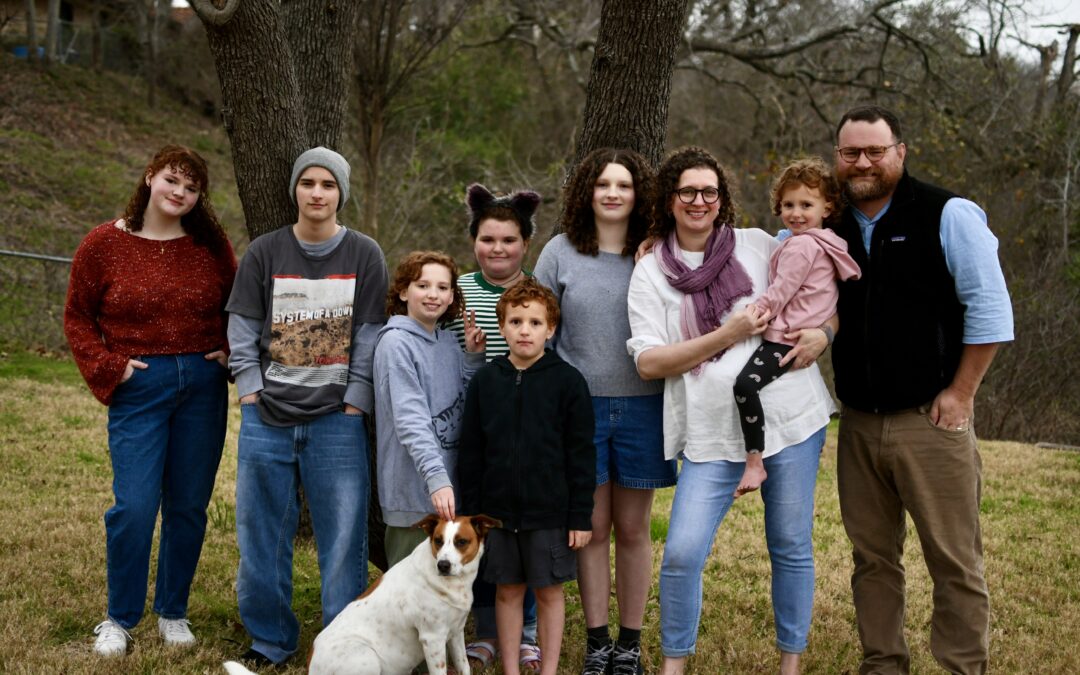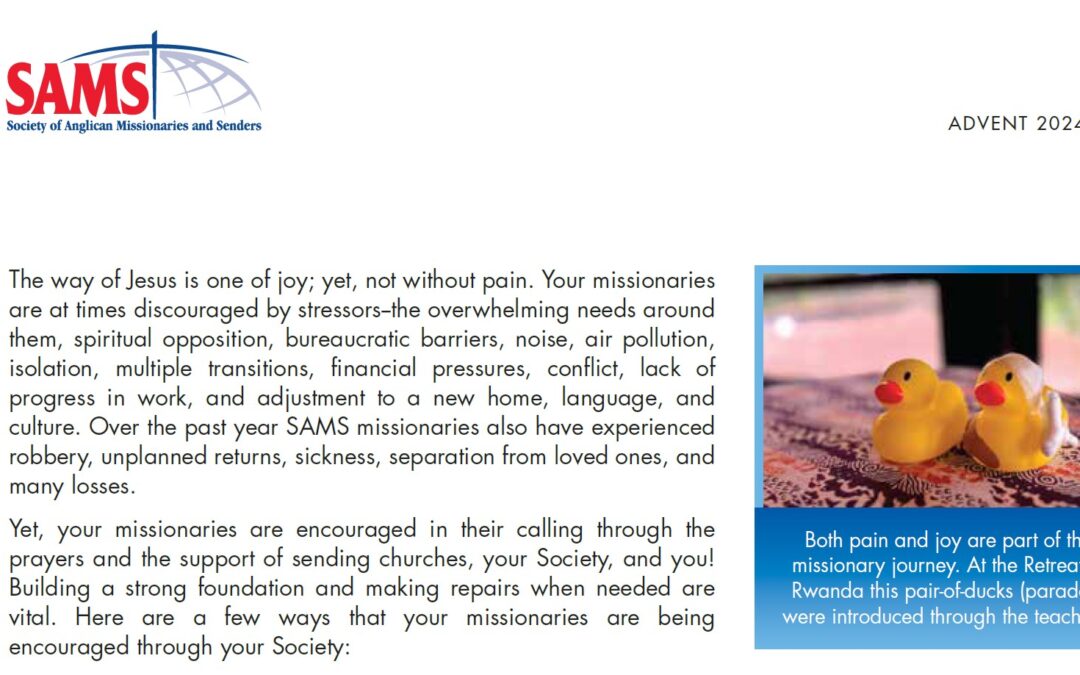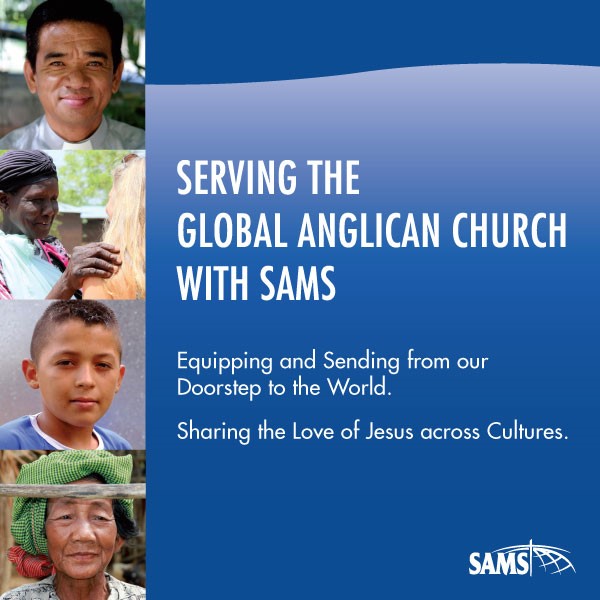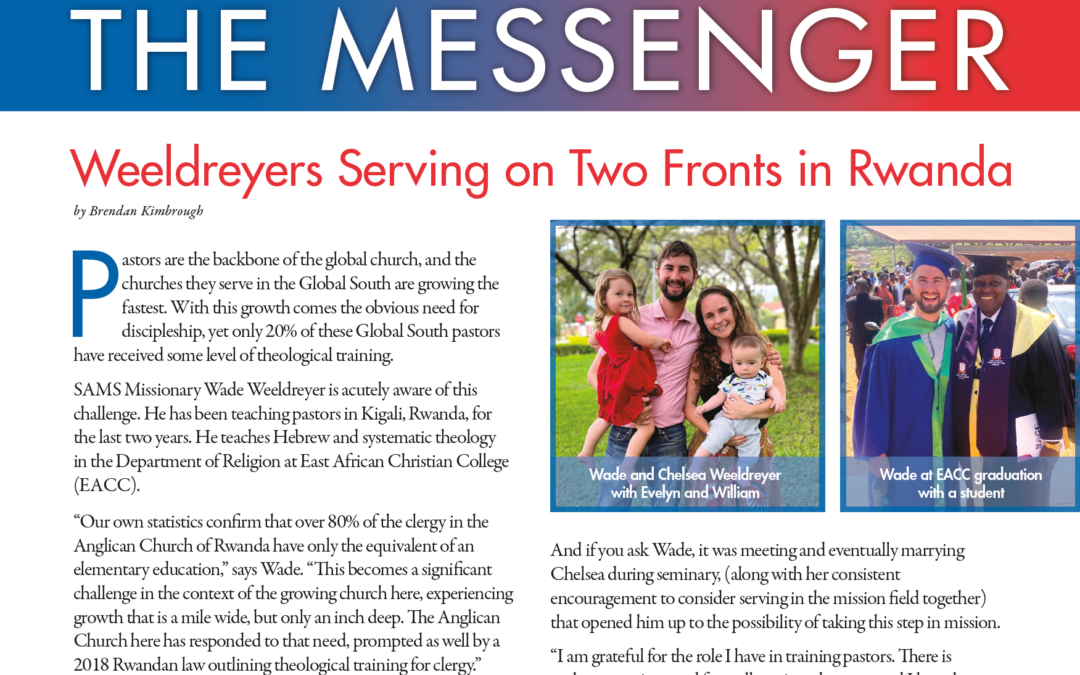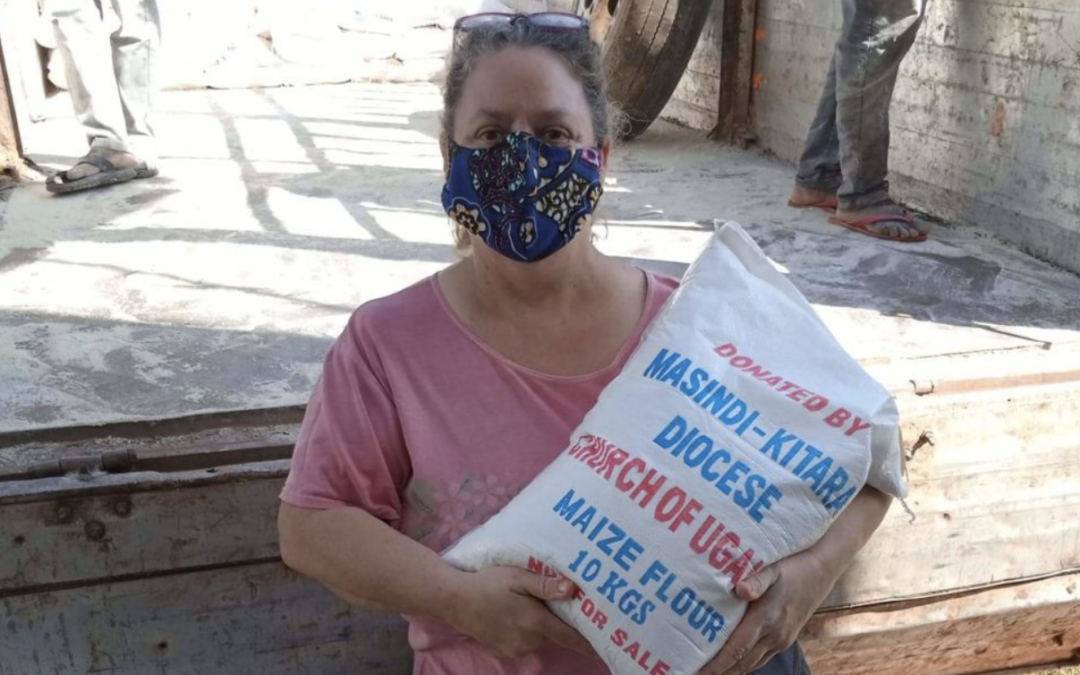
by Lee Nelson | Feb 26, 2025 | SAMS Missionaries
Jesus said to them again, “Peace be with you. As the Father has sent me, even so I am sending you.” (John 20:21)
The idea of mission is not an exclusively Christian term. Corporations have mission statements. Astronauts are given missions. In one of my favorite movies, two bluesmen set out on a “mission from God” to save their childhood orphanage. The word is a Latin one, missio, and simply means “to send.” So, when Latin translators of the New Testament set out to translate passages like the one above, the choice required very little thought: missio.
It is from this simple, probably mindless choice in translation that we get the whole concept of mission. It is simply to say that we Christians understand ourselves to be a sent people, a people on the move. The Apostles understood that if they were anything, they were men who had been sent out – to Judea, Samaria, and to the ends of the earth. (Acts 1:8) If you track the story of the Acts of the Apostles, this is exactly what happens. On the day of Pentecost, the apostles are driven by the Holy Spirit out of the room where they were staying and the Gospel is proclaimed to Jews from all over the world. At the end of Acts, Paul and his party have come to Rome in chains. How did these early missionaries think about themselves? The answer, I think, comes in the Gospel of John. On the very day Jesus is raised from the dead, he appears among the disciples and offers a very Jewish greeting: “Peace be with you.” This is not all he says. The Lord could have simply said “I am sending you,” but in addition to giving them a mission, he makes it clear how and by what power they are sent.
“As the Father has sent me.”
Another way to put this phrase could be something like “In the same way as the Father has sent me.” And how has the Lord Jesus been sent by the Father? Several things can be said about this, but let’s start with the immediate. The immediate sending, which the disciples would have been perplexed by, was this astonishing presence of their Lord among them when three days before, he had been brutally disfigured, crucified, and laid in a tomb. Friends, this is the power, the nuclear engine, behind the Church’s mission in the world, the same power which raised Jesus from the dead. The mission of the Church is fueled by the astonishing and miraculous work of the Holy Spirit. The disciples are sent, to put it simply, as a Resurrected Body into the world. This is the nature of the Church, being the body of all those who have been baptized, buried with Christ, and raised with him to eternal life. (Romans 6)
Consider another angle. Jesus is sent not only by the power of the Holy Spirit, but as God and Man in one divine person. He is not sent as an idea, or an invisible spirit, or just a human being. The eternal Word of the Father is sent in the flesh. And the apostles are sent in the same way. I heard recently of a Christian who was setting out to plant a church entirely online. While I’m sure his intentions are good, this is not mission according to the mission of Jesus. The Apostles understood that they could not just send a letter and be done with it. They had to go in person.
But, there is so much more, consider what Jesus was sent to do! To heal the sick, to drive out demons, and proclaim the Kingdom of God! In this time, people were very aware that Caesar Augustus had proclaimed his own rule with supposed miracles. Therefore they understood that for Jesus to go around proclaiming a kingdom and healing the sick was nothing less than a challenge to the status quo of the empire. While making no violent or existential threat to the empire, it is a serious challenge nonetheless, serious enough that he was crucified for the crime of insurrection. In every age, missionaries have been sent, not to overthrow governments, but to proclaim the kingdom of God while simultaneously feeing the hungry and healing the sick, often in miraculous ways.
The bigger idea that I want you to get is this: that Jesus is sending out his Church on mission as the continuation of His incarnate body on Earth. This is why Paul writes “You are the body of Christ.” (1 Corinthians 12:27) The Church is that body which proclaims the Gospel of the Kingdom and participates sacramentally in the Lord’s incarnate body. The ancient Church understood, as we do today, that the fuel for mission is the very indwelling of human life by the Holy Spirit, nourished by participation in the Eucharist, and all of this “for the life of the world.” For this reason, we can say with confidence that every Christian, no matter where they are or what they do for a living, is a missionary. The existence of so-called missionaries only reenforces the point: the particular subsists in the whole.
As the Church is sent out into the world, her aim is no different from that of her Lord: to love and save lost humanity. I can think of no better mission statement.

by Brendan Kimbrough | Feb 21, 2025 | Europe, SAMS Missionaries
New SAMS Missionary Candidates Lee and Ela Nelson are responding to a call to contribute to the re-evangelization of Europe through the Knüll Camp and Conference Center in Schwarzenborn, Germany. Two ACNA jurisdictions will come alongside Lee and Ela and their children for a collaborative sending effort. Both the Reformed Episcopal Church (REC) Board of Foreign Missions and the Diocese of the Fort Worth are engaged in directly supporting and encouraging others to join this ministry as Senders of the Nelson family.
For five decades REC Bishop Gerhard Meyer with his wife Grace led the Camp, where many have been blessed in the Lord. As the new director, Lee will be developing a training center to encourage the planting of healthy, multiplying churches throughout Europe.
While work needs to be done to upgrade the camp, Lee and Ela envision it as a strategic place to launch initiatives like the training center. A second focus will be to make the camp a hospitable refuge for beleaguered Christians, lay and clergy alike. Please pray for the Nelson family as they seek Senders and then transition
from Texas to Germany to equip and refresh the church.
Visit the Nelson’s page

by Brendan Kimbrough | Nov 5, 2024 | SAMS Missionaries
EXPLORE CROSS-CULTURAL MINISTRY
Discern your talents and vocational calling
ZOOM EVENT
TUESDAY, NOVEMBER 12th at 8:00PM ET
The Anglican Church is rapidly expanding, especially in the Global South, and SAMS is meeting this demand head-on with a range of opportunities for cross-cultural service in the many countries where the church is present. We partner with dioceses and parishes who know the cultural context and we work to walk alongside those who are discerning a call to help clarify and guide.
You’ll hear from SAMS Mission Directors and five different SAMS Missionaries about the present landscape internationally and domestically for long-term and short-term service opportunities. Learn how you might serve the global church in theological education, teaching, outreach to refugees and more, and why cross-cultural service is so exciting and fulfilling.
TO ATTEND: Contact Nita via email at info@sams-usa.org and request the Zoom link
You will have the opportunity to hear from SAMS missionaries about their experiences serving both in the U.S. and globally. They will be available to answer your questions.
Hosted by:
Stewart Wicker – SAMS President and Mission Director
Denise Cox – Associate Mission Director
SAMS Missionaries

Bishop Todd and Patsy McGregor – Todd is a SAMS Missionary Coach and spent years serving as a missionary throughout Africa.

Rev. Jessica Hughes – Jessica has experience serving in theological education in Uganda.

Rev. Daniel and Rebecca Behrens – Daniel and Rebecca minister among refugees and recent immigrants in Pittsburgh.

Lucy Chaves – Lucy overseas the SAMS Bridger Program, a short-term intern service program. She mentors youth in Kenya through her ministry, Kenya Connection, encouraging them to be Godly leaders.

Anthony and Anna Pelloni – The Pellonis serve in Cambodia helping to disciple young Cambodians are helping to plant a new Cambodian church.
TO ATTEND: Contact Nita via email at info@sams-usa.org and request the Zoom link

by Brendan Kimbrough | Aug 30, 2024 | Health, SAMS Missionaries, Uganda
Life is busy for Janine LeGrand. This long-tenured SAMS Missionary works tirelessly to improve the healthcare of the people in the Masinda-Kitara Diocese in western Uganda. Janine is constantly educating people about practicing good health in her job as the Diocesan Health Coordinator. Think basic information like clean water practices, good nutrition, and sanitation. But where Janine makes the biggest impact is showing the love of Jesus through her personal interactions throughout the area. Recently she hosted the members of the Diocesan Office (the Secretariat) to her home to strengthen bonds and show them some of the ways she prepares healthy food.

Her diocese has a close working relationship with One World Health (OWH). The U.S. OWH Medical Team was about to do one of there regular medical visits, and Janine’s team of volunteers were busy organizing the sites where the teams meet patients. Partnering with three parishes, Janine’s team, the OWH Team and workers from Masindi Kitara Hospital saw well over 1,200 people across 5 days. This gives Janine and her team ample opportunity to visit with people and pray with them. They also share the Gospel of Jesus Christ.
The Lord has used many experiences in Janine’s life to prepare her for the mission field. Born in Los Angeles, Janine attended UCLA but left after a year to pursue her interest in feeding people sustainably through fish farming in Hawaii. There were fish farms in Hawaii and her parents had recently moved there, so it seemed a good fit. Here fish farming work led her to earn a degree in Zoology and she began teaching science in Hawaii. An opportunity opened up in Japan and she taught there for three additional years, but she felt herself becoming burned out on teaching. She retrained first as a vet lab tech and then in medical assisting. Through these experiences God placed a burden on her for the mission field.
Janine works with people to also fit them with reading glasses. It began with an emphasis on church leaders, but she opened it up to the community when she was able to acquire enough glasses. What a huge difference it makes when a person can read the Bible again, or when an accountant can see well enough to keep the books. In addition to fitting people with glasses, she continue to distribute health messages through church leaders, WhatsApp and text messages. Her health education information is now being sent to schools in the area as well.

Janine is always looking for ways to innovate where health education, nutrition and creation care meet. With deforestation becoming a much bigger issue and burning bans being enacted in some areas of Uganda, Janine has been working on a design for a solar stove that people can use to cook healthy meals without burning wood, and doing so inexpensively.


